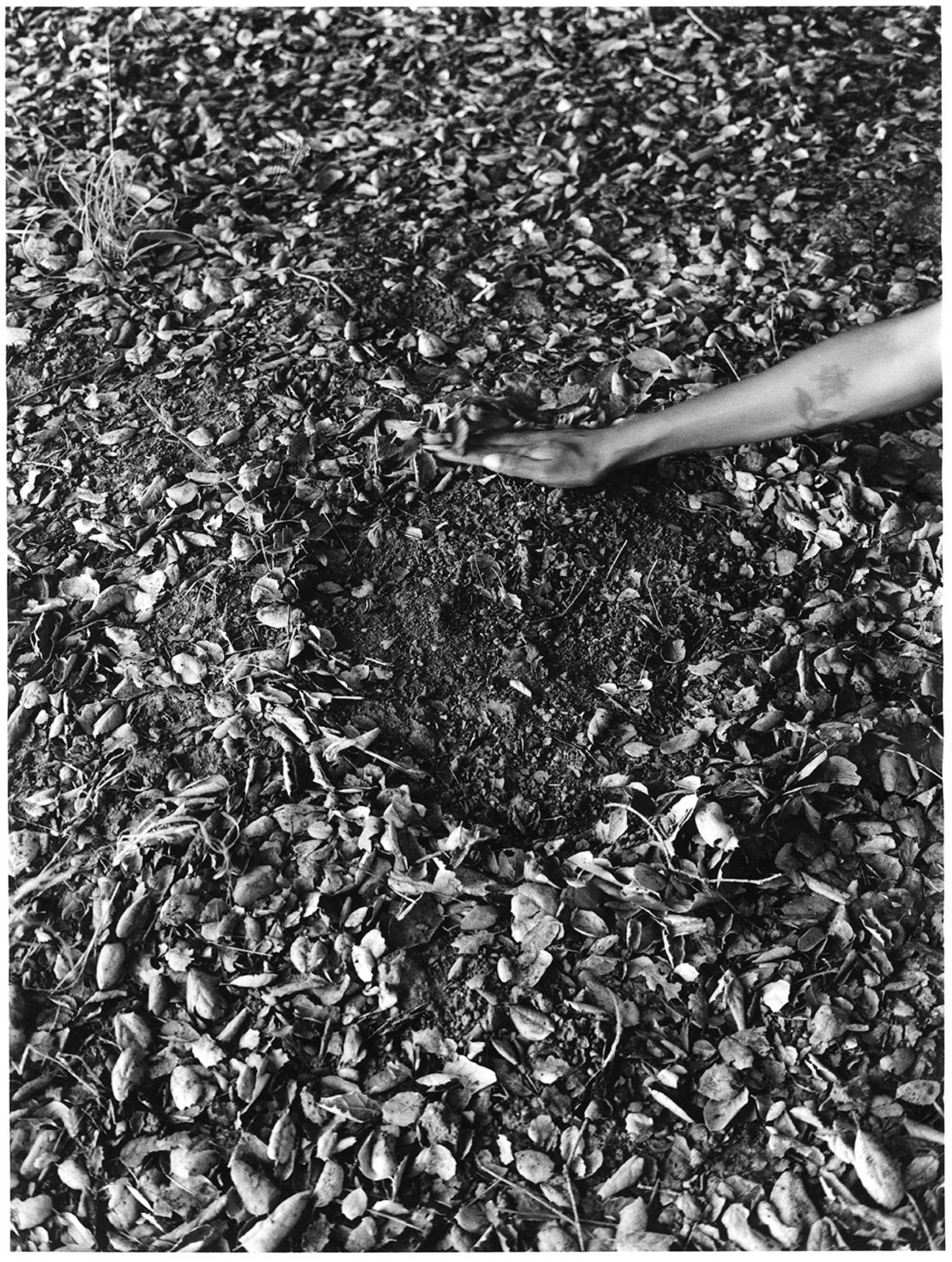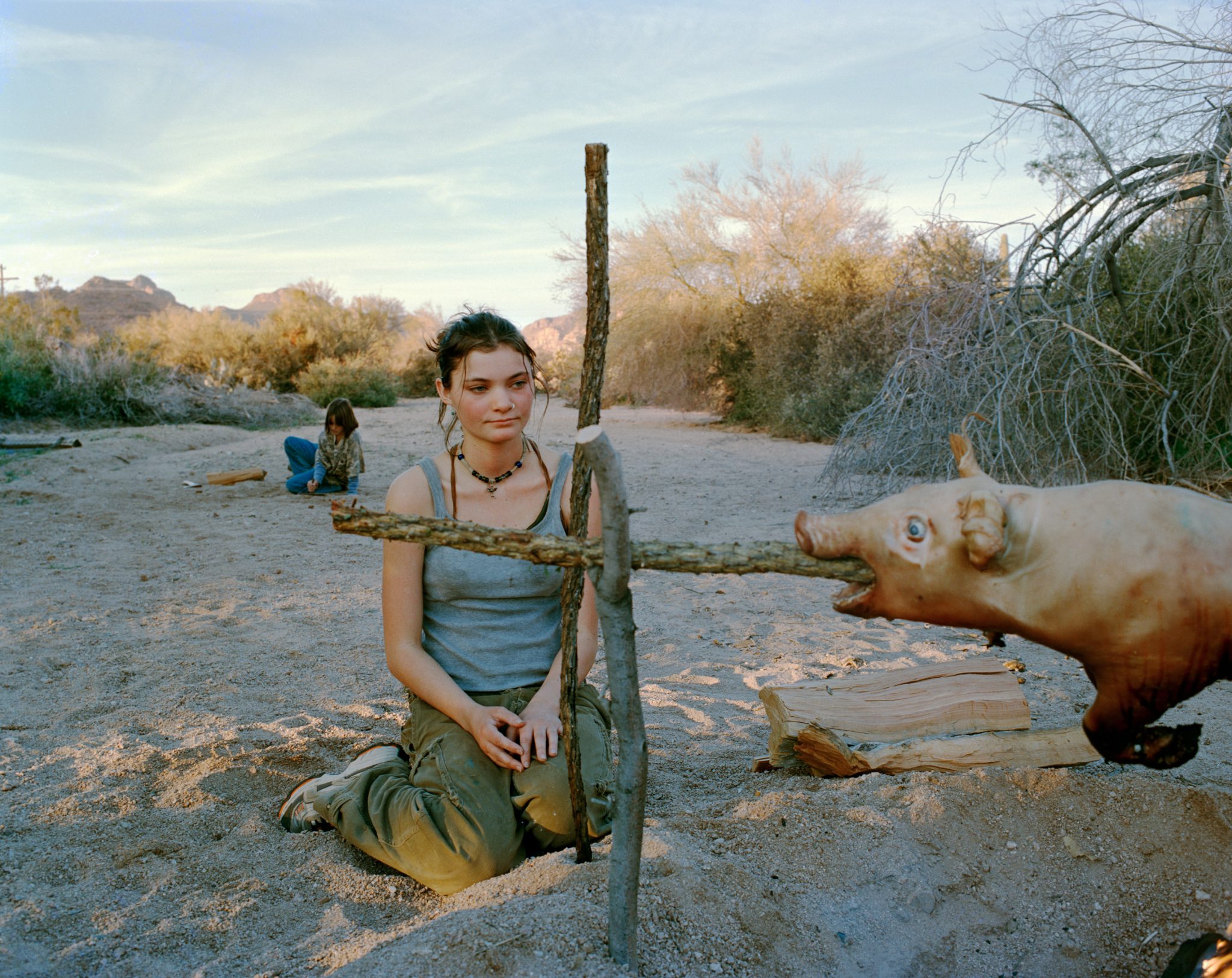What belongs in a landscape, and who in front of a camera? The genre is about more than just the nineteenth-century notion of the sublime
A luminous photograph in the Carnegie Museum of Art shows two figures on a patch of sand. One, a child, digs with a stick, while the other, an adolescent wearing a grungy outfit, beaded choker and nose ring, minds a pig on a spit. In this inkjet print by Justine Kurland, titled The Pig Roast (Apache Junction, Arizona) (2001), there is a quietude atypical of survival scenes, as well as a staginess in the way the adolescent’s hands are gathered in her lap, the pristine condition of her shoes and the look of cautious amusement she gives the skewered animal. The image comes from Kurland’s Girl Pictures series (1997–2002), which depicts groups of young women playacting as vagabonds in wildernesses across North America, trekking through terrain like the male adventurers in a Jack Kerouac novel and injecting a convivial presence into the bleak American landscape found in, say, Robert Frank’s roadtrip photographs.

Kurland’s photos hang among other subtly incongruous vistas in Widening the Lens, a 19-artist show that seeks to revise the somehow imperishable nineteenth-century notion of landscape – as an uninhabited, sublime mirror of egoistic projection – into one that better reflects the current, stressed state of the planet and the full range of lived experiences shaped by its compromised wildernesses. Acknowledging that the genre of landscape photography was, since the 1870s, coopted by American surveyors to erase nonmale, nonwhite and Indigenous subjects from the land – the catalogue notes how, for instance, photographs of the Yellowstone River taken on an 1871 US-sponsored expedition failed to depict local Indigenous populations – the exhibition attempts to counter this erasure by presenting images in which marginalised subjects are situated in natural environments in stereotype-defying ways, marshalling incongruity, as Kurland has, to call attention to viewers’ biases about what and who belongs in a landscape and in front of a camera.

Like Kurland, David O. Alekhuogie performs an act of reparative restaging in his series to live and die in LA (2021). On two inkjet-printed canvases, the blue and red waistbands of a man’s exposed underwear and low-slung pants are blurred and interposed behind palm fronds and other foliage growing in locations where, according to the wall text, Black men have had violent encounters with the Los Angeles police. Under Alekhuogie’s lens, the stacked waistbands – targets of a moral panic during the early 2000s – turn into a radiant backdrop, reframing the Black male body as a site of intimacy rather than paranoia. Elsewhere, in the three sequenced prints that make up Dionne Lee’s Casting series (2022), the artist’s hands reach in from the left of one frame and appear, in the next two frames, to drop a rock onto pebbled ground, staking a claim to the land in a magnificently opaque and noninvasive manner. Agential and expressive, they stand in for the Black citizen who was banned from American national parks, the exhibition materials inform us, until the Civil Rights Act of 1963. A similar opacity is found in Sky Hopinka’s inkjet print Cowboy Mouth 3 (Siniwagúreginągere) (2022), in which two figures and a row of trees, backlit and inscrutable against a pale blue sky, are haloed with lines of poetry. In lieu of distinct markers of identity, the artist’s verses etched on the print do the work of reinscribing Indigenous subjectivity onto the tableaux of America.

In ‘A Short History of Photography’ (1931), Walter Benjamin observed that photographs often reveal that which eludes sense perception. Lucy Raven’s Demolition of a Wall (Album 2) (2022), one of the show’s final works, taps into what Benjamin termed the ‘optical unconscious’ by pairing an investigative agenda with advanced image-capture technology. This 15-minute film, presented on a vertical LED screen with an immersive sound system, examines an explosives-testing site in New Mexico. Aiming a high-speed camera at a mountainside, Raven indexes blast waves created by ammunition companies and US departments as they spread in arcs over the landscape, causing disruption invisible to the naked eye. Demolition of a Wall thus calls attention to – and mounts evidence against – the private and public entities that exploit the land for their experiments. It shows what the rest of the exhibition implies: that contemporary lens-based art can be vital to climate activism when it makes visible what is wilfully obscured and makes suspect what has been unconsciously accepted.
Widening the Lens: Photography, Ecology, and the Contemporary Landscape at Carnegie Museum of Art, Pittsburgh, through 12 January 2025
